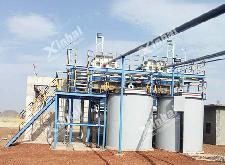

Warm Tip: If you want to know more details about equipment, solutions, etc, please click the button below for free consultation, or leave your requirements!
In this post, we're going to talk about how to fill the ball mill with steel balls for the first time?
We'll do it in these 4 steps:
Loading principle
Steel ball diameter
Loading steps
Let's dive right in!
Steel balls are the main grinding media for ball mills. General ball mill initially loaded ball, the size of the steel ball, the number, proportion, which aspect is added wrong, will directly affect the grinding efficiency of the ball mill. In addition, in the process of grinding, the steel ball after high intensity grinding, resulting in wear, breakage, loss of round, will also reduce the grinding efficiency of the ball mill. Therefore, it is very important to ensure the initial amount of ball loading and correct judgment of ball abrasion and timely addition of ball.

When the ball mill is initially loaded, it must be ensured that the type of loaded ball, the diameter of the ball and their weight ratio are all suitable for the nature of the materials to be ground. Under normal circumstances, the feed size will be different, therefore, need to mix large balls.
When the ball loading rate (or the weight of the steel ball) is constant, the number of small ball diameter is more, and the number of hits per cycle is also more. Therefore, in terms of the ratio of ball diameter, the combination of large and small balls not only has enough striking force, but also has more striking times and strong grinding effect.
General experience is: ball mill initial load should account for 80% of the total amount of ball, the proportion of the large ball and roughly the percentage of coarse ore is equivalent, the proportion of the small ball and roughly the percentage of fine ore is consistent. To accurately fill the initial amount of balls, the following formula should be used for calculation:
Table of relationship between diameter of steel ball loaded by ball mill and size of ore particles:
The steel ball diameter(mm) | 120 | 100 | 90 | 80 | 70 | 60 | 50 | 40 |
The ore grain diameter I | 12~18 | 10~12 | 8~10 | 6~8 | 4~6 | 2~4 | 1~2 | 0.3~1 |
The ore grain diameter II | 20 | 10 | - | 5 | 2.5 | 1.2 | 0.6 | 0.3 |
The filling-in calculation: D=id^n
D – steel diameter (mm)
d – feeding ore grain diameter (mm)
i and n – the index about mineral character
The first filling-in calculation follows these steps:
The sand return ratio of the classifier is measured, and the new feed ore and the sand return are screened out to calculate the particle size composition of the whole feed ore of the ball mill.
From the grain size composition of the total ore, the grain size that does not need to be ground further is deducted, and the remaining grain size is converted into a new percentage. The newly converted percentage was then properly divided into several groups, each group according to the formula and table 1 to find the diameter of the steel ball to be used, and to determine the proportion of the various balls. The weight percentage of each diameter ball is roughly equivalent to the percentage of each ore particle on which they are calculated;
According to the proportion of each ball and the total weight of each ball, the loading weight of each ball is calculated.
The above are the loading principles, loading steps and diameter of ball mill. When adding steel balls to the ball mill, pay attention to the above matters. You can also consult with professional ball mill manufacturers.
1 3 Aspects of Ball Mill Maintenance
 -1085
-1085
 4369
4369
2What Are the Requirements for Ball Mill Testing, Start and Stop?
 1
1
 3254
3254
3Ball Mill: Is the Grinding Fineness the Finer, the Better?
 10
10
 6048
6048


What Are the Differences Between CIP and CIL?
 10376
10376
 0
0